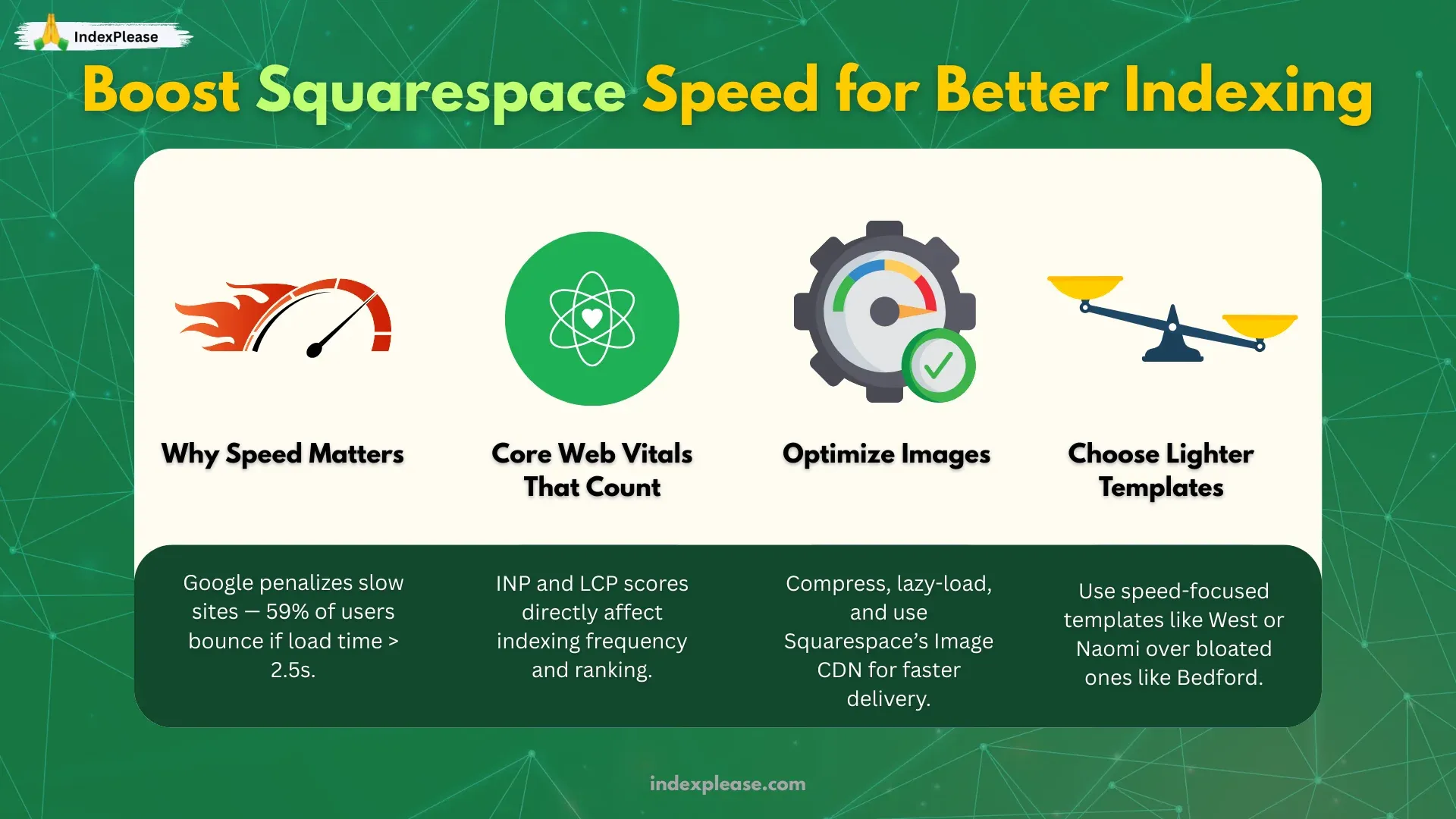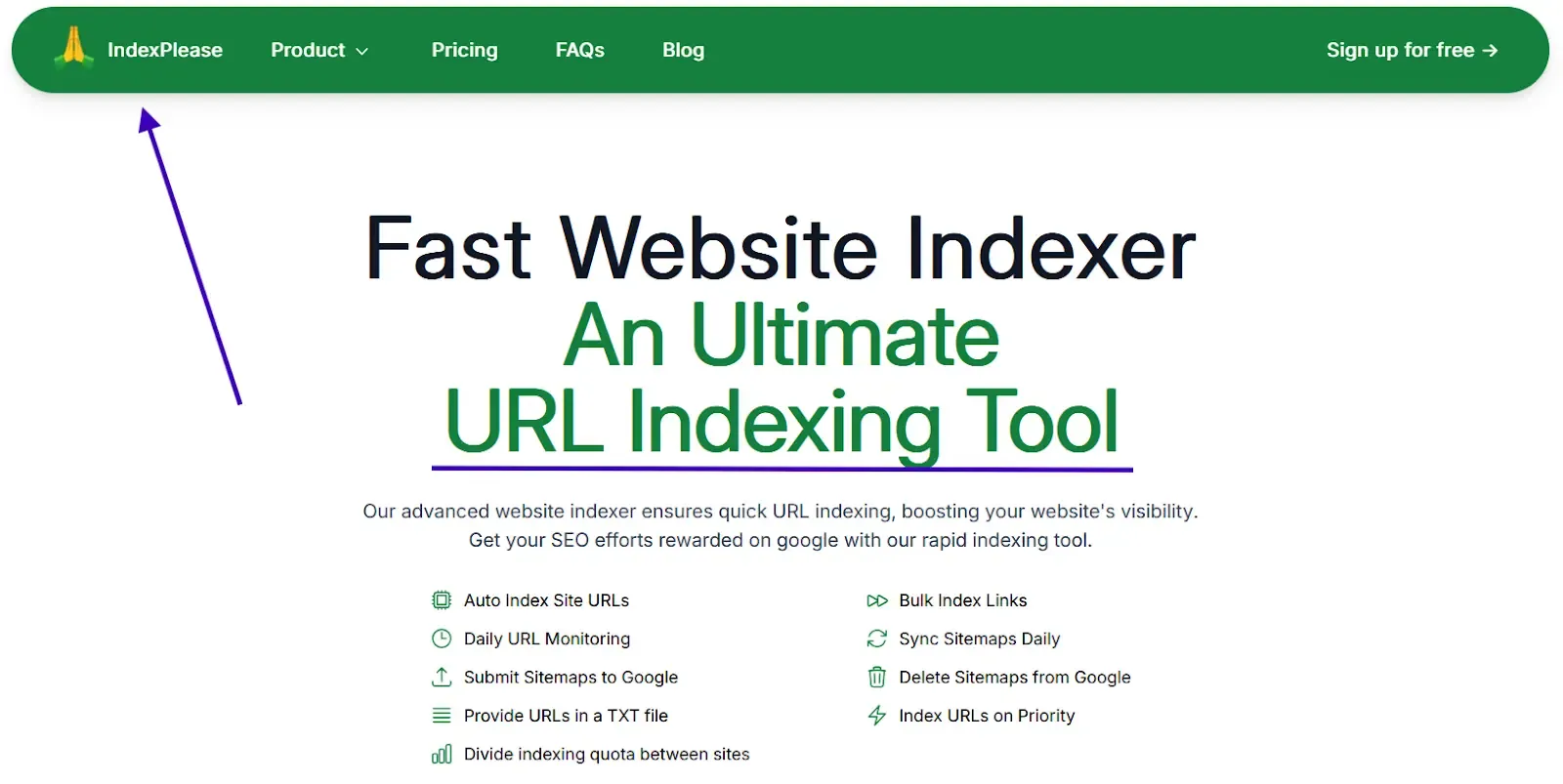
How to get your Squarespace site indexed in 2025
You clicked “Publish” on your Squarespace site, hoping Google would notice, but nothing happens.
- Google’s mobile-first crawl now abandons pages slower than 2.5 seconds (LCP threshold) and 38% of Squarespace sites fail this due to bloated templates.
- AI Overviews devour 34% of organic clicks by answering queries like “best eco-friendly yoga mats” before showing real result.
- Squarespace’s closed-stack quirks, like ghost /config/ preview URLs and duplicate blog tags, silently sabotage indexing. Ahrefs found 61% of Squarespace sites have 100+ accidental duplicate pages.
The stakes? Pages taking >72 hours to index lose 58% of their first-month traffic. Sites with “Poor” Core Web Vitals get 53% fewer inclusions in AI Overviews.
But here’s the good news: Indexing isn’t luck. This guide cracks Squarespace’s code with technical fixes, structured data hacks and automation tricks to make Google beg to crawl your site.
What is indexing?
Indexes are formed after search engines crawl your blog, analyze it and store relevant information for future reference. Every time a blog is indexed more effectively, it increases the chances of appearing in search results. Higher visibility in search results leads to more site visitors which helps in increasing traffic organically. Indexing is extremely important for blog success and repeating that statement is justified for how impactful indexing can be.
1. Fix the Foundations Inside Squarespace

Squarespace’s SEO panel is like a locked toolbox, you need the right keys to unlock its potential.
A. Clean HTTPS & Trailing Slash Handling
Problem: Mixed HTTP/HTTPS content or inconsistent trailing slashes (/blog vs. /blog/) confuse crawlers. Fix:
- Go to Settings > Advanced > SSL and enforce “Secure Preferred.”
- Use URL Mappings (Settings > Advanced) to standardize trailing slashes.
B. Slug Hygiene
Squarespace auto-generates slugs like /blog/2025/05/15/untitled-post. Google hates these. Fix:
- Edit slugs manually to be keyword-rich (e.g., /blog/seo-tips-2025).
- Use hyphens, not underscores and keep slugs under 70 characters.
C. Built-In SEO Panel Tweaks
- Meta Descriptions: Avoid Squarespace’s default “Posted on May 15” filler text.
- Indexing Toggle: Disable indexing for draft/utility pages (e.g., /thank-you, /admin).
2. Build a Sitemap Google Actually Loves
Let’s turn Squarespace’s basic sitemap into a Google magnet, no coding or Dev Mode required. Why Squarespace’s Default Sitemap Fails
- Googlebot gets lost in giant sitemaps (like a 500-page book with no chapter titles).
- No “last updated” dates mean Google treats your 2025 product edits like stale 2019 content.
- Sneaky draft pages and /config/ test URLs clutter your sitemap, wasting crawl budget.

How to Get Your Squarespace Site Indexed Quickly
Indexing isn’t magic, it’s a process. Here’s how to fast-track your Squarespace site into search engines’ good graces:
1. Leverage Squarespace’s Built-In XML Sitemap
Squarespace automatically generates an XML sitemap at yourdomain.com/sitemap.xml. This file lists every page, product and blog post on your site in a format Google and other engines understand.
But here’s the catch:
- The default sitemap includes all pages, even drafts, test URLs and low-priority pages.
- It lacks critical metadata like <lastmod> (last modified date), which tells Google what’s new.
Your move:
- Verify your sitemap is active: Visit yourdomain.com/sitemap.xml.
- Trim the fat: Use Google Search Console to exclude non-essential pages (Settings > Old/Unused Pages > Remove).
2. Submit Your Sitemap to Search Engines
Squarespace’s sitemap is useless if search engines don’t know it exists. Submit it to:
- How to set up Google Search Console
- How to set up Bing Webmaster Tools
- How to set up Yandex Webmaster Tools
- How to set up Seznam.cz Webmaster Tools
- How to set up Naver Webmaster Tools
Pro Tip:
Submit once, then automate: Tools like IndexPlease monitor sitemap changes and auto-ping search engines, saving you hours of manual work.
3. Manual Submissions: The Last Resort
Manually submitting pages is like knocking on Google’s door one URL at a time, it works, but it’s slow and unreliable.
When to use it:
- Urgent launches (e.g., Black Friday product drops).
- Pages stuck in “Discovered – Not Indexed” limbo.
How to do it:
- How to submit pages for indexing to Google
- How to submit pages for indexing to Bing
- How to submit pages for indexing to Yandex
- How to submit pages for indexing to Seznam.cz
- How to submit pages for indexing to Naver
The problem:
- Manual submissions don’t guarantee indexing.
- Large sites (500+ pages) become a full-time job.
The Smarter Way: Automate
Tools like IndexPlease eliminate grunt work by:
- Auto-submitting new/updated pages via IndexNow (Bing/Yandex) and Google’s Indexing API.
- Bypassing daily limits with shared quotas (index 1,000+ pages/day).
- Integrating directly with Squarespace’s CMS (no coding).
3. Canonicals & Duplicate-Page Traps Unique to Squarespace
Squarespace’s “helpful” features often backfire, creating duplicate content Google hates. Let’s clean up the mess, no coding required.
The 4 Duplicate Culprits
1. Blog Tag Pages
- Problem: Squarespace auto-creates pages like /blog/tag/yoga that compete with your main blog posts.
- Fix: Go to Blog Settings > SEO and toggle “Noindex” for tag pages.
2. /config/ Preview URLs
- Problem: Test pages like /config/2025-summer-collection-preview get indexed accidentally.
- Fix: Use Google’s Removals Tool to delete them, then block via robots.txt with apps like Robots.txt Editor.
3. Image Pages
- Problem: Every image upload creates a page (e.g., /images/photo.jpg), which Google sees as thin content.
- Fix: Go to Design > Image Loading and enable “Lazy Loading + Noimageindex.”
4. 301 Redirect Chains
- Problem: Multiple redirects (e.g., Page A → Page B → Page C) slow down crawls.
- Fix: Audit redirects with Screaming Frog (free) and simplify to direct 301s.
5. Core Web Vitals & Image Performance on Squarespace
Google doesn’t just prefer fast sites, it punishes slow ones. If your Squarespace site takes longer than 2.5 seconds to load, you’re already losing 59% of potential visitors. Here’s how to fix it without hiring a developer.

Why Speed = Indexing Power
- INP (Interaction to Next Paint) <200 ms: Measures how quickly buttons, forms or menus respond. Squarespace’s default templates often fail this due to bloated JavaScript.
- LCP (Largest Contentful Paint) <2.5 seconds: The time it takes for your hero image or headline to load.
- Google’s “Fast Track” Crawl: Sites with “Good” Core Web Vitals get crawled 2x more often.
3 Fixes for Lightning-Fast Loads
1. Optimize Images (Without Losing Quality)
- Enable Squarespace’s Image CDN: Go to Settings > Website > Image Loading and toggle “Enable Image CDN.”
- Compress Images Before Uploading: Use free tools like Squoosh.app or ShortPixel to shrink file sizes by 60-80%.
- Add Lazy Loading: In Design > Image Loading, select “Lazy Load Images.”
2. Ditch Bloated Templates
- Avoid: Templates like “Bedford” or “Five” (heavy animations, parallax scrolling).
- Use: Lightweight templates like “West” or “Naomi” (built for speed).
3. Audit Third-Party Apps
- Guilty Parties: Pop-ups (Privy), live chat (Tidio) and countdown timers.
- Fix: Replace heavy apps with lightweight alternatives:
- Pop-ups: Swap Privy for Squarespace’s native Announcement Bar.
- Live Chat: Use Paperbell (loads 3x faster).
6. Automate Discovery: URL Inspection, IndexNow, & IndexPlease
Waiting for Googlebot to stumble onto your new pages is like mailing a postcard and praying it arrives. Let’s force search engines to notice your Squarespace site, instantly.

Why Automation Is Non-Negotiable
- Google’s Indexing API processes updates 5x faster than organic crawls.
- IndexNow (adopted by Bing/Yandex) lets you ping search engines directly, but Squarespace doesn’t natively support it.
- Manual “Request Indexing” in Search Console caps you at 10 URLs/day. For stores with 500+ products, this is useless.
Way to Automate? (No Coding) Let’s be real, no one has time to sit around manually submitting URLs and praying Google notices. It’s boring, it’s slow and it’s exhausting as a matter of fact. That’s why we built IndexPlease, your personal indexing machine that never sleeps.
For just $7/month (less than your Netflix), we’ll automatically submit up to 400 pages per day, across 5 of your sites, to Google, Bing, Yandex, Seznam.cz and Naver, all without you lifting a finger. Most of your pages? Indexed in under 48 hours. Yes, really.
And that’s just the beginning. IndexPlease doesn’t just automate indexing, it gives you full control over visibility, crawl budget, and search presence like never before.
Curious what else it can do? Check out the full power list here.
- Auto Index Site URLs – submit and index daily without lifting a finger
- Daily URL Monitoring – check indexing status and catch errors early
- Bulk Index Links – submit hundreds of URLs in one go
- Provide URLs in TXT File – get downloadable proof of what’s indexed
- Index URLs on Priority – flag new launches to show up fast
- Divide Indexing Quota Between Sites – perfect for agencies or multi-store owners
Whether you’re dealing with slow sitemaps, duplicate pages or missed crawls, IndexPlease gives you the full indexing toolkit. Automate it all and reclaim your search visibility.
FAQs
1. Does Squarespace support automated indexing natively?
No. Squarespace doesn’t offer built-in support for Google’s Indexing API or IndexNow. That’s where tools like IndexPlease come in, integrating automation without needing dev access.
2. What’s the fastest way to get new Squarespace pages indexed?
Use a tool like IndexPlease to auto-submit URLs the moment you publish. It works through Zapier triggers or direct API integration, submitting to Google, Bing and Yandex in one click.
3. How do I fix issues with sitemap syncing on Squarespace?
Squarespace’s default sitemap is static. IndexPlease automatically syncs your sitemap daily, submits it to Google and even deletes outdated ones, no manual work required.
4. Can I track which of my Squarespace pages are actually indexed?
Yes. IndexPlease offers Daily URL Monitoring and even provides a downloadable .TXT file of your indexed and pending URLs so you know what’s visible, and what’s not.
5. What if I run multiple Squarespace sites?
With IndexPlease, you can divide your indexing quota across different projects. Whether it’s client sites or a personal portfolio + blog, you can prioritize indexing smartly.
6. Does IndexPlease help with duplicate content or canonical issues?
It doesn’t change your code, but by pushing the correct versions of your URLs to Google first, IndexPlease helps prioritize canonical pages and reduce the impact of duplicates.
7. How many URLs can I index per day using IndexPlease?
Depending on your plan, IndexPlease allows indexing from 400 to 2000+ pages/day, far more than Google’s 10 URL/day manual submission limit.
8. Can I prioritize certain Squarespace pages to get indexed faster?
Yes. You can mark high-priority pages for faster indexing using the “Index URLs on Priority” feature in IndexPlease, ideal for new launches, product drops or seasonal content.
Final Thoughts
Publishing your Squarespace site and waiting for Google to notice is no longer an option.
With AI Overviews stealing clicks, Core Web Vitals acting as gatekeepers and search engines tightening crawl budgets, getting indexed fast is now a business-critical move, not just an SEO checkbox.
This guide gave you the technical groundwork:
- Fix your slug hygiene
- Clean up your sitemap
- Patch duplicate traps
- Speed up your load times
But let’s be honest, manual fixes can only take you so far.
If you’re serious about getting indexed fast, reliably and at scale, automation is no longer a luxury. It’s the only way to stay competitive.
That’s why IndexPlease exists: To take the crawling chaos off your plate, so your content gets the visibility it deserves.
Whether you’re running a portfolio, a client’s eCommerce store or a multi-language blog empire, automated indexing isn’t just easier, it’s smarter.
So don’t wait for traffic. Trigger it. Let IndexPlease make Google come to you.